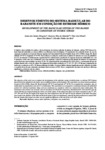Use este identificador para citar ou linkar para este item:
http://biblioteca.incaper.es.gov.br/digital/handle/item/500| Título: | Desenvolvimento do sistema radicular do rabanete em condição de estresse hídrico. |
| Título(s) alternativo(s): | Developmente of the radicular system of the radish in condition of hydric stress. |
| Autor(es): | BREGONCI, I. dos S.  ALMEIDA, G. D. de.   BRUM, V. J.   ZINI JÚNIOR, A.   REIS, E. F. dos.   Izaias dos Santos Bregonci, Incaper; Gustavo Dias de Almeida; Vitor José Brum; Alaert Zini Júnior; Edvaldo Fialho dos Reis.   |
| Palavras-chave: | Raphanus sativus Deficiência hídrica Irrigação Raiz Produtividade |
| Data do documento: | 9-Jan-2015 |
| Editor: | Idesia, Chile, v. 26, n. 1, 2008. |
| Descrição: | O objetivo desse trabalho foi avaliar o desenvolvimento do sistema radicular de plantas de rabanete, cultivar VIP Crimson Seleção Especial submetido ao estresse hídrico em diferentes fases fenológicas. O experimento foi conduzido dentro de casa de vegetação, localizado no Centro de Ciências Agrárias da Universidade Federal do Espírito Santo (CCA-UFES), Alegre-ES, Brasil (latitude 20º 45 S e longitude 41º 30 W). Para realizar as avaliações, mantiveram-se plantas de rabanete em vasos de polietileno de 4,5 L de substrato. O delineamento experimental foi o inteiramente casualizado no esquema de parcela subdividida 4x5, com 4 repetições, sendo cada vaso considerado como uma repetição, a qual foi composta por três plantas de rabanete. Os tratamentos na parcela foram estresse hídrico nas fases II; III e IV, respectivamente, denominados D7; D14 e D21 e, a testemunha D0 que foi irrigada durante todo o ciclo da cultura. Na subparcela foram feitas avaliações ao 7º; 14º; 21º; 28º e 35º dia para comprimento da maior raiz e avaliações ao 28º e 35º dia para diâmetro do bulbo. O estresse hídrico diminui significativamente o diâmetro do bulbo e a matéria fresca da raiz, reduzindo a produção final em torno of 50%. Para o comprimento da maior raiz não houve diferença significativa ao final do ciclo da cultura. The objective of this work was to evaluate the development of the radicular system of radish plants, to cultivate VIP Crimson Special Selection submitted to the hydric stress in different phases of development. The experiment was driven inside greenhouse located in (CCA-UFES), Alegre-ES, Brazil (latitude 20th 45 S and longitude 41th 30 W). To accomplish the evaluations, they set radish plants in polyethylene vases of 4,5 L of substratum. The experiment was arranged in a randomized design with subdivided portion 4x5, with four repetitions, being each pot considered as a repetition, which was composed by three radish plants. The treatments in the portion were in hydric stress in the phases II; III and IV, respectively, denominated D7; D14 and D21 and, the witness D0 that was irrigated during the whole cycle of the culture. In the subsections there were made evaluations to the 7th; 14th; 21th; 28th and 35th day for length of the largest root and evaluations to the 28th and 35th day for diameter of the bulb. The hydric stress reduces the diameter of the bulb and the fresh matter of the root significantly, reducing the final production in around 50%. Para the length of the largest root there was not significant difference at the end of the cycle of the culture. |
| URI: | http://biblioteca.incaper.es.gov.br/digital/handle/item/500 |
| Aparece nas coleções: | Memória Técnica do Incaper  |
Arquivos associados a este item:
| Arquivo | Descrição | Tamanho | Formato | |
|---|---|---|---|---|
| Izaias-rabanete-Idesia-sr-2008-izaias.pdf | 178,38 kB | Adobe PDF |  Visualizar/Abrir |
Os itens no repositório estão protegidos por copyright, com todos os direitos reservados, salvo quando é indicado o contrário.
